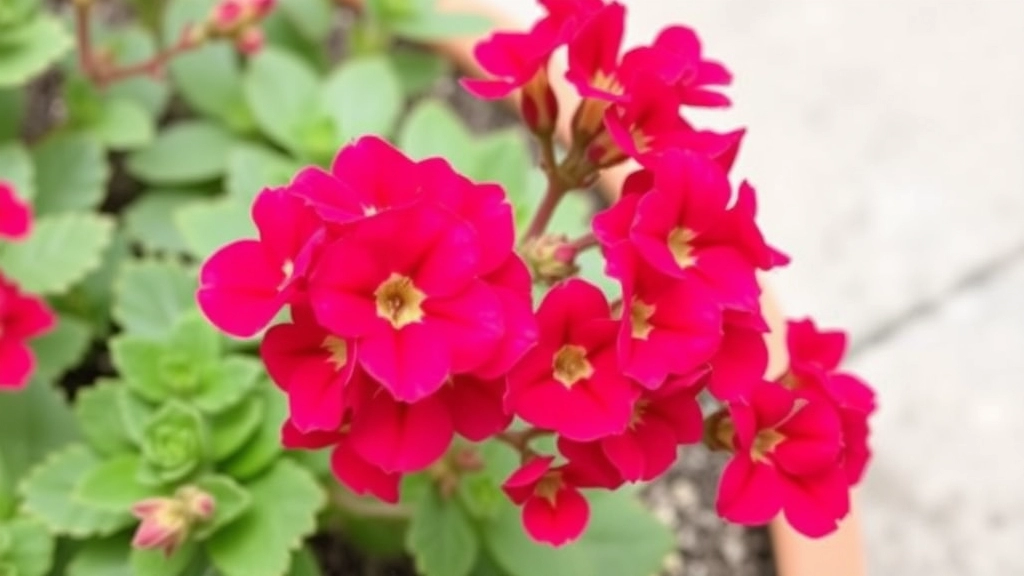Growing Kalanchoe: Sunlight or Shade?
When it comes to growing Kalanchoe, one of the most common questions is whether they thrive better in full sun or shade. As a plant enthusiast, I’ve experimented with various lighting conditions to find the perfect balance for these vibrant succulents.
From my experience, Kalanchoe plants do best in bright, indirect sunlight. Direct full sun can be too harsh and cause leaf burn, while too much shade can lead to leggy growth and fewer blooms. Finding that sweet spot of filtered light will keep your Kalanchoe healthy and blooming beautifully.
Are you struggling to keep your Kalanchoe thriving?
Understanding the optimal light conditions is crucial for nurturing this vibrant succulent.
Kalanchoe plants flourish in bright, indirect light, making them perfect for sunny windowsills or well-lit spaces.
**Key Points for Optimal Light Conditions:**
– **Bright, Indirect Light:** Aim for around 6 hours of bright, indirect sunlight daily.
– **Avoid Harsh Sunlight:** Direct sunlight, especially during peak hours, can scorch the leaves.
– **Supplemental Lighting:** If natural light is limited, consider using grow lights to provide the necessary brightness.
For outdoor settings, a spot with filtered sunlight is ideal.
In contrast, indoor Kalanchoe may need a little extra care to ensure they receive enough light without the risk of burning. For more specific tips, you can refer to this [complete care guide for Kalanchoe](https://planthq.org/complete-care-guide-for-kalanchoe-synsepala-baker/) or learn about the [best practices for indoor and outdoor care](https://planthq.org/kalanchoe-best-practices-for-indoor-and-outdoor-care/).
Effects of Full Sun on Kalanchoe
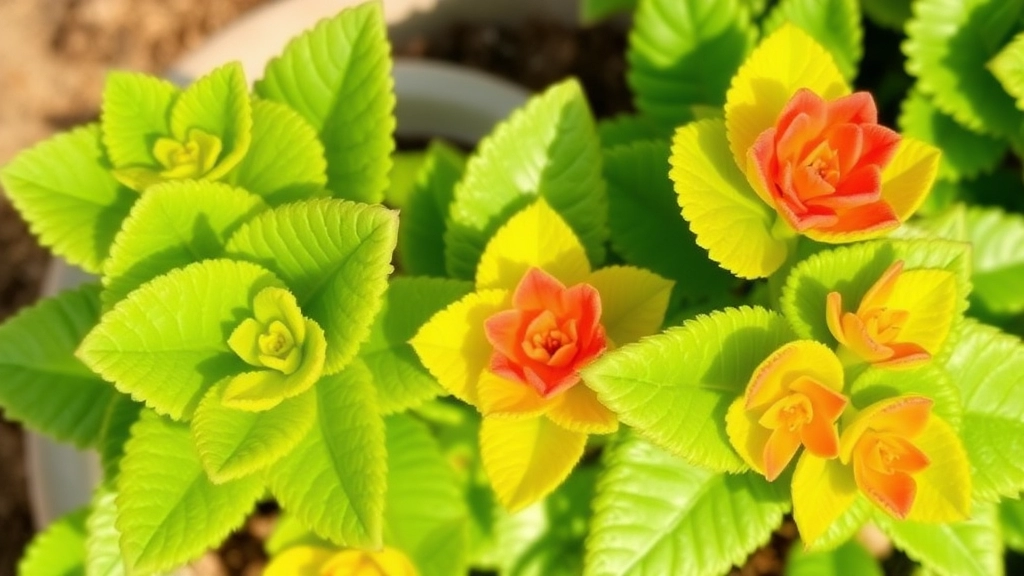
Ever wondered how your Kalanchoe would thrive in full sun?
Well, it’s a bit of a double-edged sword.
On one hand, Kalanchoe loves bright light.
But too much direct sun can be a real challenge.
Benefits of Full Sun
- Vibrant Blooms: When placed in full sun, Kalanchoe tends to produce more flowers.
- Healthy Growth: The plant grows more robustly, with thicker stems and lush leaves.
Risks of Full Sun
However, here’s where it gets tricky:
- Leaf Burn: Intense sunlight can scorch the leaves, turning them brown and crispy.
- Water Needs: Full sun means your plant will dry out faster, requiring more frequent watering.
- Stress Levels: Too much sun can lead to stress, making your Kalanchoe more susceptible to pests and diseases.
Finding the Sweet Spot
So, how do you balance it?
- Morning Sun: A few hours of gentle morning sunlight is ideal.
- Shade in Afternoon: Consider providing some afternoon shade to protect your plant from harsh rays.
Growing Kalanchoe in Partial Shade
When considering the optimal conditions for your Kalanchoe, you might wonder how it fares in partial shade.
Kalanchoe is a resilient plant, but it thrives best under specific light conditions.
Understanding Partial Shade
Partial shade typically refers to areas that receive filtered sunlight or indirect light for a portion of the day.
This can be an ideal environment for Kalanchoe, especially in regions with intense summer heat.
Key Benefits of Growing Kalanchoe in Partial Shade:
- Reduced Stress: Less direct sunlight can prevent leaf scorch and stress.
- Consistent Growth: Your Kalanchoe can maintain steady growth without the risk of wilting.
- Extended Blooming Period: Flowers may last longer without the harsh effects of full sun.
Ideal Locations for Partial Shade
Consider placing your Kalanchoe in locations such as:
- Under a tree canopy
- Near a window that filters light
- On a patio with dappled sunlight
These spots can provide the balance of light your plant needs.
Watering Considerations
In partial shade, Kalanchoe may require less frequent watering. For more detailed watering tips, you can refer to the Mother of Thousands care guide.
Monitor the soil moisture to avoid overwatering, as shaded areas can retain moisture longer.
Signs of Success
If your Kalanchoe is thriving in partial shade, you’ll notice:
- Vibrant green leaves
- Healthy flower buds
- Steady growth patterns
These indicators show that you’ve found the right balance for your plant. For more insights on keeping your plant healthy, you might find the Kalanchoe care tips for thriving in Texas climate useful.
Indoor vs Outdoor Kalanchoe Light Requirements
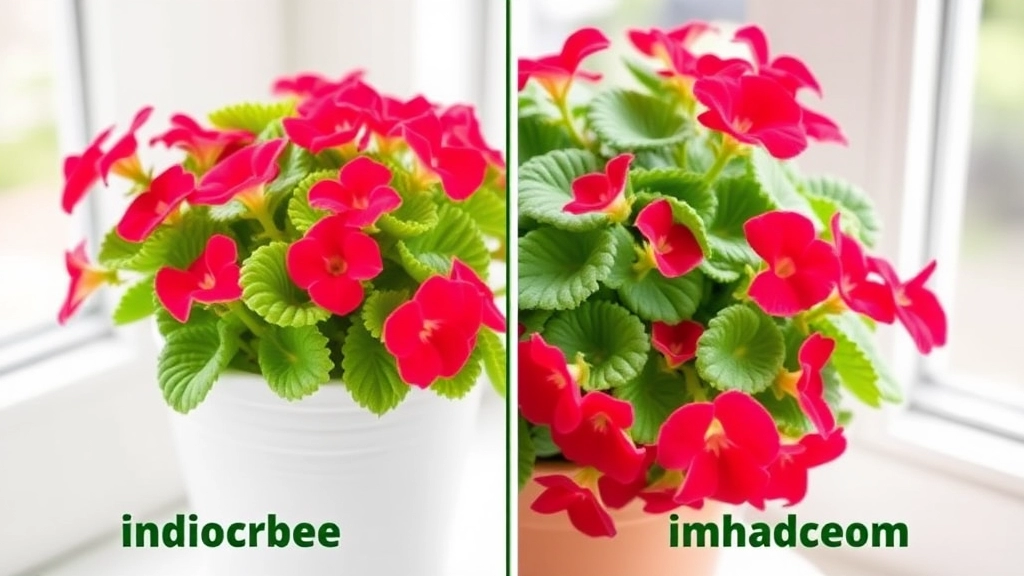
When considering the best light conditions for your Kalanchoe, it’s essential to recognise the differences between growing them indoors and outdoors. Each environment presents unique challenges and opportunities that can significantly impact your plant’s health.
Indoor Kalanchoe Light Requirements
Indoor Kalanchoe plants thrive best in bright, indirect sunlight. Here are key considerations for indoor care:
- Location: Place your Kalanchoe near a south or west-facing window for optimal light exposure.
- Duration: Aim for at least 6 hours of light daily. If natural light is limited, consider supplementing with grow lights.
- Avoid Direct Sunlight: Direct sunlight can scorch the leaves, leading to unsightly damage.
Outdoor Kalanchoe Light Requirements
Outdoor Kalanchoe can benefit from more intense sunlight, but it’s crucial to find the right balance. Here’s what to keep in mind:
- Sun Exposure: Kalanchoe prefers full sun for at least 4 to 6 hours a day, especially in cooler climates.
- Temperature Considerations: During extreme heat, provide some afternoon shade to prevent wilting.
- Soil and Drainage: Ensure well-draining soil to avoid root rot from excessive moisture.
Comparative Insights
Both indoor and outdoor settings can support healthy Kalanchoe growth, but your approach should vary:
- Light Intensity: Indoor plants may require additional light sources, while outdoor plants benefit from natural sunlight.
- Humidity Levels: Indoor environments tend to be drier, requiring more attention to watering and humidity levels.
- Pest Management: Outdoor Kalanchoe may face more pest challenges, making regular checks essential.
Seasonal Light Adjustments for Kalanchoe
As we consider the optimal light conditions for Kalanchoe, it’s essential to recognise that these plants have specific light needs that fluctuate with the seasons.
Understanding Seasonal Changes
Kalanchoe thrives in bright, indirect light, but as the seasons change, so do its light requirements.
- Spring and Summer: During these warmer months, Kalanchoe benefits from increased sunlight. Aim for:
- 6 to 8 hours of bright light each day.
- If outdoors, ensure protection from harsh midday sun to prevent leaf scorch.
- Autumn and Winter: As daylight hours decrease, your Kalanchoe may need adjustments:
- 4 to 6 hours of bright light is sufficient.
- Consider moving your plant closer to windows that receive more sunlight.
Practical Tips for Seasonal Adjustments
- Rotate Your Plant: Every couple of weeks, rotate your Kalanchoe to ensure even light exposure.
- Use Sheer Curtains: If indoors, sheer curtains can help diffuse harsh sunlight while still providing brightness.
Monitoring Light Conditions
Keep an eye on your Kalanchoe’s response to seasonal changes. Signs of inadequate light include:
- Stretching: If your plant starts to elongate, it may be reaching for more light.
- Fading Colours: Dull leaves can indicate insufficient sunlight.
By making these seasonal adjustments, you can keep your Kalanchoe healthy and vibrant throughout the year. For more detailed care information, check out our Kalanchoe Flaming Katy care guide and our tips on growing Kalanchoe indoors.
Signs of Light Stress in Kalanchoe
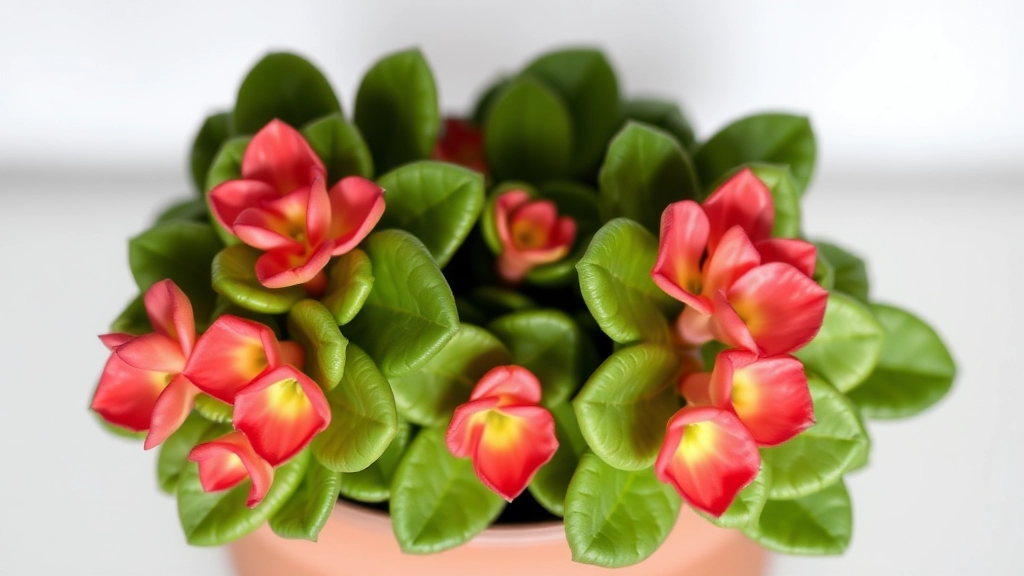
So, you’ve got your Kalanchoe looking all vibrant, but what happens when it starts to show signs of distress?
Light stress is a real thing, and knowing how to spot it can save your plant from a downward spiral.
Here are some key signs that your Kalanchoe may be struggling with its light conditions:
- Leggy Growth: If your Kalanchoe is stretching towards the light, it’s a sign it’s not getting enough. You might notice long stems and sparse leaves.
- Leaf Discoloration: Yellowing leaves can indicate too much direct sunlight, while pale leaves might mean it’s not getting enough light.
- Leaf Drop: Losing leaves can be a sign of stress. If your Kalanchoe is shedding leaves, it might be time to reassess its light situation.
- Burned Edges: Brown, crispy edges on leaves? That’s often a sign of too much sun exposure.
- Slow Growth: If your plant seems to be in a growth slump, it could be a light issue. Kalanchoes thrive in the right light, and if they’re not getting it, they’ll let you know.
Keep an eye out for these signs, and you’ll be able to adjust your Kalanchoe’s environment accordingly.
Tips for Balancing Sun and Shade
Finding the right balance of sun and shade for your Kalanchoe can seem daunting. Are you worried about your plant getting too much sun or not enough? You’re not alone. Many enthusiasts face the same challenge. Here are some straightforward tips to help you achieve the perfect light conditions for your Kalanchoe.
1. Gradual Acclimatisation
If you’re moving your Kalanchoe from indoors to outdoors, do it gradually. Start by placing it in a shaded spot for a few days before introducing it to direct sunlight. This prevents shock and allows the plant to adjust.
2. Monitor the Time of Day
Morning sun is gentler than afternoon sun. If possible, position your Kalanchoe where it can bask in the morning light but is sheltered from the harsher afternoon rays. This balance can promote healthy growth.
3. Use Shade Cloth
If your Kalanchoe is in a location that receives intense sunlight, consider using a shade cloth. This can filter the light and provide your plant with the protection it needs without completely blocking the sun.
4. Rotate Your Plant
To ensure even growth, rotate your Kalanchoe every few weeks. This helps all sides receive equal exposure to light, preventing lopsided growth.
5. Observe and Adjust
Keep an eye on your plant’s response to its environment. If the leaves start to look bleached or scorched, it may be getting too much sun. Conversely, if the plant becomes leggy or fails to bloom, it might need more light.
6. Seasonal Changes
As the seasons change, so does the intensity and duration of sunlight. Be prepared to adjust your Kalanchoe’s location accordingly. In winter, it may need to be moved closer to a window, while in summer, it might benefit from a bit more shade. For more detailed guidance, check out our Ultimate Guide to Caring for Kalanchoe Flaming Katy.
Additionally, if you’re interested in learning more about the different types of Kalanchoe you can grow, don’t miss our Top Succulent Kalanchoe Types for Your Garden.
Common Mistakes in Kalanchoe Lighting
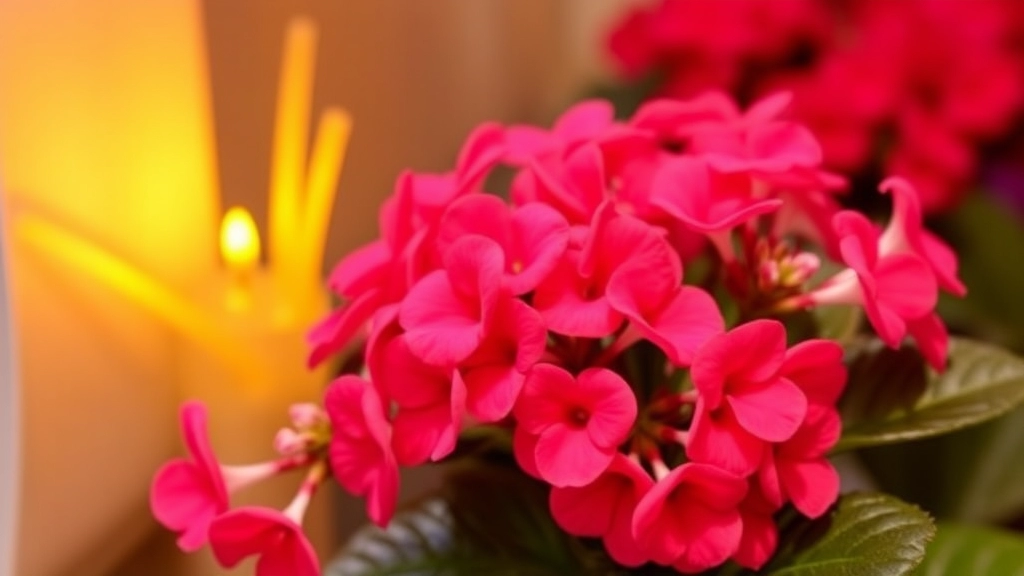
So, you’ve got your Kalanchoe, and you’re ready to give it the best light possible. But wait—are you making some common lighting mistakes?
Let’s dive into the pitfalls that many of us stumble into when it comes to lighting our Kalanchoe.
1. Too Much Direct Sunlight
While Kalanchoe loves bright light, too much direct sun can scorch those beautiful leaves.
- Tip: If your plant starts to look crispy, it’s time to move it back a bit.
2. Not Enough Light
On the flip side, if your Kalanchoe is sitting in a dim corner, it’s not going to thrive.
- Tip: Aim for a spot with bright, indirect light. If it’s stretching towards the light, it’s a sign it’s not getting enough.
3. Ignoring Seasonal Changes
Light conditions change with the seasons, and so should your plant’s location.
- Tip: As winter rolls in, you might need to shift your Kalanchoe closer to a window.
4. Overthinking Indoor vs. Outdoor
Some folks think indoor plants need less light. Not true! Indoor Kalanchoe can still thrive with the right amount of light.
- Tip: Use grow lights if natural light is lacking.
5. Forgetting to Rotate
Plants can lean towards the light source, leading to uneven growth.
- Tip: Rotate your Kalanchoe every few weeks for balanced growth.
Best Practices for Healthy Kalanchoe Growth
As we explore the best practices for ensuring your Kalanchoe thrives, it’s essential to remember that optimal light conditions play a pivotal role in their overall health.
Key Practices for Optimal Growth
- Choose the Right Location:
- Ensure your Kalanchoe receives bright, indirect sunlight.
- Avoid placing them in direct sunlight for extended periods to prevent leaf burn.
- Monitor Watering:
- Allow the soil to dry out between waterings.
- Overwatering can lead to root rot, so check for dryness before adding more water.
- Utilise Quality Soil:
- Use a well-draining potting mix, preferably one designed for succulents.
- This helps prevent water accumulation, promoting healthy root growth.
- Fertilisation:
- Feed your Kalanchoe with a balanced fertiliser during the growing season (spring and summer).
- A diluted liquid fertiliser every month can boost growth without overwhelming the plant.
- Temperature Control:
- Keep your Kalanchoe in a warm environment, ideally between 15°C to 25°C.
- Avoid exposing them to cold drafts or sudden temperature changes.
- Pruning:
- Regularly remove dead or yellowing leaves to encourage new growth.
- This also helps in preventing pests and diseases.
- Pest Management:
- Keep an eye out for common pests like mealybugs and aphids.
- Use insecticidal soap or neem oil for treatment if needed.
For more detailed information on specific Kalanchoe varieties, check out our Mother of Thousands care guide and our Flapjack care guide.
FAQs on Kalanchoe Light Requirements
What are the benefits of placing Kalanchoe in full sun?
Vibrant Blooms: When placed in full sun, Kalanchoe tends to produce more flowers.
Healthy Growth: The plant grows more robustly, with thicker stems and lush leaves.
What are the risks of exposing Kalanchoe to too much direct sunlight?
Leaf Burn: Intense sunlight can scorch the leaves, turning them brown and crispy.
Water Needs: Full sun means your plant will dry out faster, requiring more frequent watering.
Stress Levels: Too much sun can lead to stress, making your Kalanchoe more susceptible to pests and diseases.
How can I balance sunlight exposure for my Kalanchoe?
Morning Sun: A few hours of gentle morning sunlight is ideal.
Shade in Afternoon: Consider providing some afternoon shade to protect your plant from harsh rays.
What are the light requirements for indoor Kalanchoe?
Location: Place your Kalanchoe near a south or west-facing window for optimal light exposure.
Duration: Aim for at least 6 hours of light daily. If natural light is limited, consider supplementing with grow lights.
Avoid Direct Sunlight: Direct sunlight can scorch the leaves, leading to unsightly damage.
What are the light requirements for outdoor Kalanchoe?
Sun Exposure: Kalanchoe prefers full sun for at least 4 to 6 hours a day, especially in cooler climates.
Temperature Considerations: During extreme heat, provide some afternoon shade to prevent wilting.
Soil and Drainage: Ensure well-draining soil to avoid root rot from excessive moisture.
What are the signs of light stress in Kalanchoe?
Leggy Growth: If your Kalanchoe is stretching towards the light, it’s a sign it’s not getting enough. You might notice long stems and sparse leaves.
Leaf Discoloration: Yellowing leaves can indicate too much direct sunlight, while pale leaves might mean it’s not getting enough light.
Leaf Drop: Losing leaves can be a sign of stress. If your Kalanchoe is shedding leaves, it might be time to reassess its light situation.
Burned Edges: Brown, crispy edges on leaves? That’s often a sign of too much sun exposure.
Slow Growth: If your plant seems to be in a growth slump, it could be a light issue. Kalanchoes thrive in the right light, and if they’re not getting it, they’ll let you know.
What are common mistakes in Kalanchoe lighting?
1. Too Much Direct Sunlight
While Kalanchoe loves bright light, too much direct sun can scorch those beautiful leaves.
Tip: If your plant starts to look crispy, it’s time to move it back a bit.
2. Not Enough Light
On the flip side, if your Kalanchoe is sitting in a dim corner, it’s not going to thrive.
Tip: Aim for a spot with bright, indirect light. If it’s stretching towards the light, it’s a sign it’s not getting enough.
3. Ignoring Seasonal Changes
Light conditions change with the seasons, and so should your plant’s location.
Tip: As winter rolls in, you might need to shift your Kalanchoe closer to a window.
4. Overthinking Indoor vs. Outdoor
Some folks think indoor plants need less light. Not true! Indoor Kalanchoe can still thrive with the right amount of light.
Tip: Use grow lights if natural light is lacking.
5. Forgetting to Rotate
Plants can lean towards the light source, leading to uneven growth.
Tip: Rotate your Kalanchoe every few weeks for balanced growth.
References
-
Kalanchoe Light Requirements: How Much Light Does Kalanchoe Need?
-
How to Grow Kalanchoe Indoors
-
Kalanchoe: How to Grow and Care for Kalanchoe Plants
